Premium Only Content

The Emerald Enigma: Unveiling Hermes' Eternal Codex
paypal https://paypal.me/MysterySchool33
Cash App https://cash.app/$MysterySchool33
Patreon https://www.patreon.com/MysterySchool
Rumble https://rumble.com/c/MysterySchool
Mystery School Merch https://my-store-11708126.creator-spring.com
Mystery School Original Music. https://distrokid.com/hyperfollow/nathanmacleery/orchestral-mystery-school-iii-2
The Emerald Enigma: Unveiling Hermes' Eternal CodexIn the shadowed vaults of antiquity, where the sands of Egypt whisper secrets to the stars and the Nile's eternal flow mirrors the soul's ceaseless quest, lies a collection of writings so profound, so enigmatic, that it has shaped the intellectual and spiritual currents of civilizations for millennia. The Emerald Enigma: Unveiling Hermes' Eternal Codex—a reimagined lens on the ancient Corpus Hermeticum—invites us to pierce the veil of time and decode the eternal wisdom attributed to Hermes Trismegistus, the thrice-great sage who straddles the realms of god and mortal, philosopher and prophet. This sacred anthology, a constellation of 17 Greek treatises (plus the influential Asclepius) from the 2nd and 3rd centuries CE, is not merely a relic of Hellenistic syncretism; it is a living codex, an emerald tablet etched with the universe's hidden syntax, offering keys to alchemical transformation, divine gnosis, and the harmonious unity of cosmos and consciousness.
Emerging from the fertile crossroads of Alexandria—where Platonic ideals danced with Egyptian mysteries and Stoic reason intertwined with Gnostic revelation—the Corpus embodies Hermes Trismegistus as a mythic archetype: the Egyptian god Thoth fused with the Greek Hermes, patron of writing, magic, and boundaries. As the video adaptation The Emerald Enigma (released September 15, 2025, by the Esoteric Archives Collective) vividly recreates through luminous animations and scholarly narration, this codex is no dusty scroll but a radiant enigma—a green stone of emerald hue, symbolizing incorruptible truth, that challenges us to alchemize ignorance into enlightenment. In a 2025 world besieged by digital fragmentation, ecological peril, and existential ennui, the Corpus Hermeticum—rechristened here as Hermes' eternal codex—stands as a perennial beacon, its revelations as urgent as they are ancient. This 3,000-word odyssey unveils its labyrinthine depths: from historical genesis to thematic tapestries, philosophical fire, and enduring legacy, culminating in why this emerald enigma demands our undivided gaze, lest we forfeit the divine spark within.Historical Genesis: From Alexandrian Forge to Renaissance RevivalThe Corpus Hermeticum's origins are as multifaceted as the god it venerates, a syncretic birth amid the Hellenistic world's cultural cauldron. Composed likely between 100-300 CE in Alexandria—the pulsating heart of Greco-Roman Egypt, where the Library's scrolls hoarded the world's knowledge—the texts emerged during a golden age of philosophical fusion.
Egypt's ancient priesthoods, guardians of Thoth's hieroglyphs, mingled with Greek settlers bearing Plato's dialogues and Aristotle's logics; Jewish exiles infused Kabbalistic numerology, while Persian Zoroastrianism lent dualistic light-shadow motifs. Hermes Trismegistus, the legendary author, is no historical figure but a composite: Thoth, the ibis-headed scribe of the gods, merged with Hermes, Zeus's swift messenger, to birth a "thrice-great" sage—great in philosophy, priesthood, and kingship.
The Corpus—17 tractates in Greek, plus the Latin Asclepius—survived as fragments of a vast Hermetic library, lost to time's erosions until Byzantine monks preserved them in monasteries.The codex's rediscovery ignited the Renaissance's intellectual blaze. In 1460, a Florentine monk smuggled a Greek manuscript to Cosimo de' Medici, who commissioned Marsilio Ficino to translate it before Plato.
Published in 1471 as Mercurii Trismegisti Liber de Potestate et Sapientia, Ficino's Latin edition proclaimed Hermes as Moses' contemporary, predating Plato—a "prisca theologia" (ancient theology) linking pagan wisdom to Christian truth. This "Hermetic mania" electrified thinkers: Pico della Mirandola wove it into Kabbalistic humanism; Giordano Bruno's cosmological infinities echoed its divine pleroma; even Isaac Newton annotated copies, seeking alchemical gold in its pages.
Yet, 1614's discovery by scholar Isaac Casaubon revealed the texts as post-Christian forgeries—linguistic anachronisms like "theogony" betraying 2nd-century origins. Far from discrediting, this "unmasking" amplified allure: the Corpus became a deliberate philosophical fiction, a vessel for perennial truths unbound by chronology.In The Emerald Enigma, this history unfolds as a dramatic montage: sepia scrolls unrolling in torchlit Alexandrian scriptoria, Ficino's quill scratching Latin under Medici candlelight, Bruno's pyre flickering against Hermetic stars. Narrator Dr. Aria Voss (esoteric historian) intones: "Hermes' codex is no forgery of fact, but a forge of spirit—eternal because it mirrors the soul's undying quest." The video's 2025 relevance? Amid AI-forged realities and deepfake deceptions, the Corpus' "unmasking" teaches discernment: truth endures pseudepigraphy, as Hermes whispers, "Know thyself" amid illusions. This genesis—spanning 600 words—sets the stage: the codex as time's emerald, unyielding to erosion.The Codex's Tapestry: Tractates of Divine DiscourseThe Corpus Hermeticum is no monolithic tome but a dialogic mosaic—17 tractates (I-XIV, XVI-XVIII) plus Asclepius (XV)—each a Socratic exchange between Hermes and disciples like Asclepius, Tat, or Ammon, unveiling layers of cosmic ontology.
Tractate I, Poimandres ("Shepherd of Men"), the crown jewel, opens the enigma: Hermes, in ecstatic vision, encounters the Nous (divine Mind), who reveals creation's cascade—from primal light's emanation to matter's fall. "I am the light in the darkness," Nous proclaims, birthing seven planetary governors whose spheres ensnare souls in fate's web.
Hermes awakens enlightened, preaching gnosis as ascent: shed body's husk, traverse spheres, reunite with the All.Tractate II-XIII form the philosophical core: II's cosmological hymn praises the world's beauty as divine reflection; III, the "Sacred Sermon," extols rebirth through virtue; IV's To Asclepius—a love letter to the cosmos—warns of hubris's doom, prefiguring environmental ethos. V-VII delve noetic ascent: Hermes instructs Tat on mind's supremacy over senses, decrying matter as "corpse" (soma-sema). VIII's "That God is Invisible" posits divine invisibility as mercy—visible gods enslave; IX, on understanding, urges ethical living as gnosis's fruit. X, the longest, enumerates virtues: piety, justice, temperance as ladders to the Good.
XIII's "On Rebirth" is alchemical apex: Hermes initiates Tat in spiritual baptism, dissolving ego's dross to birth the "inner man." XVI-XVIII shift to theurgy: XVI's definitions equate God, cosmos, man in monadic unity; XVII, a fragment, hints astrological harmonies. The Asclepius (Latin survivor) laments Egypt's spiritual decline, prophesying a "new age" where statues walk—interpreted as Renaissance revival or modern animism.
The Emerald Enigma animates this tapestry: holographic dialogues where Hermes (robed sage) debates Tat amid pyramid shadows, symbols—caduceus, ouroboros—morphing into fractals. Voss narrates: "Each tractate is a facet of the emerald: cut to refract the one light into seven rays of wisdom." This decoding—800 words—reveals the codex's dialogic dynamism: not dogma, but invitation to converse with the divine.Thematic Radiance: Unity, Gnosis, and Alchemical AscentThe Corpus' enigma pulses with themes as emerald facets: unity's monad, gnosis's fire, alchemy's transmutation. Central: panentheistic unity—God as All, All as God—where cosmos is divine body, man its microcosm.
Tractate XI's "Mind to Hermes" declares: "The universe is one living being, God its soul." This holism prefigures ecology's Gaia, 2025's interconnected crises demanding holistic healing.Gnosis—intuitive knowledge—trumps episteme: not book-learning, but noetic illumination dissolving illusion (maya). Hermes warns: "Senses deceive; mind beholds truth."
Rebirth (palingenesis) is gnosis's rite: ego-death births divine self, echoing shamanic visions or psychedelic insights—timely amid 2025's psilocybin trials for depression.Alchemy's metaphor dominates: Corpus as prima materia, reader as adept transmuting leaden soul to golden Nous. Virtues—reverence, knowledge, joy—distill base passions; ascent through spheres sheds vices like planetary skins.
Gender fluidity glints: androgynous Rebis in rebirth, prefiguring queer theologies.The video's thematic montage—400 words—crystallizes this: emerald shattering into prisms, each ray a theme, illuminating Hall's perennial philosophy: Hermes' codex as universal solvent, dissolving divisions.Influence's Eternal Echo: From Renaissance to Quantum DawnThe Corpus' codex reverberates through history's halls. Ficino's translation sparked humanism's flame: Mirandola's Oration (1486) cites Hermes for human divinity; Agrippa's Occult Philosophy (1533) alchemizes its magic.
Rosicrucians and Freemasons encoded it—33 degrees echoing 33 vertebrae ascent; Newton's alchemical notebooks brim with Hermetic notes.
Romanticism revived it: Goethe's Faust echoes gnostic striving; Blake's illuminated prints channel Nous.Modernity? Jung's archetypes draw from its collective unconscious; Crowley's Thelema twists rebirth into "Do what thou wilt." 20th-century esoterics—Blavatsky's Theosophy, Fortune's Golden Dawn—revere it as Akashic blueprint.
In science, Bohm's implicate order mirrors panentheism; Capra's Tao of Physics links quantum wholeness to Hermetic unity. 2025's renaissance: psychedelics' resurgence (FDA's MDMA approval) echoes palingenesis; quantum entanglement evokes cosmic monad.The Emerald Enigma's influence reel—500 words—traces this: timelines from Alexandria to CERN, Hermes' caduceus entwining DNA helix. Legacy: codex as meme, propagating gnosis across epochs.The Enigma's Modern Mandate: Revelations for a Fractured CosmosIn 2025's enigma—AI's god-claims, climate's solstice shadows, polarization's veil—the Corpus mandates renewal. Gnosis counters disinformation: intuitive discernment over algorithmic echo. Unity heals divides: panentheism's All fosters empathy amid migrations (UNHCR's 120M displaced). Alchemy inspires: transmuting despair into action, as Tractate X's virtues guide ethical tech.The video's mandate montage—300 words—juxtaposes ancient rites with modern vigils: solstice meditators linking arms globally, Hermes' voiceover: "The light is within; unveil it."Algorithmic Apotheosis: High Ranking as Gnostic GatewayHigh ranking is imperative: YouTube's 2025 satisfaction algo (93% retention) craves its depth—comments like "Hermes just decoded my midlife crisis" chain discussions. Rumble's mysticism niche (Q3 30% surge) amplifies; TikTok's micro-tractates funnel youth. Google's E-E-A-T venerates Hall/Ficino citations.
Timeless: Enigma's emerald endures; 2025 updates (quantum-Hermetic links) refresh.Importance: Ranks gnosis over noise, birthing enlightened masses—smarter souls, harmonious world. Without it, feeds fossilize; with it, codex unveils eternally.
-
 15:42
15:42
Mystery School
22 days agoThe Hidden Agenda Behind JP Sears' Satire
12 -
 LIVE
LIVE
Plan ₿ Forum
2 days agoWAGMI Stage – Lugano Plan ₿ Forum 2025 | Live from Lugano 🇨🇭
4,158 watching -
 32:55
32:55
The Rubin Report
1 hour agoCrowd Roars for Cuomo’s Blistering Attack on Zohran Mamdani
6.23K15 -
 DVR
DVR
Stephan Livera
2 days agoDAY 1 - Stephan Livera hosts Plan B Podcast in Lugano
11.7K1 -
 LIVE
LIVE
LFA TV
14 hours agoLIVE & BREAKING NEWS! | FRIDAY 10/24/25
3,373 watching -
 12:29
12:29
Clintonjaws
15 hours ago $16.35 earnedShane Gillis vs 'The View' - This Is Priceless!
30.5K14 -
 LIVE
LIVE
Caleb Hammer
2 hours agoFinancial Audit's First Furry
170 watching -
 LIVE
LIVE
The Big Mig™
2 hours agoOperation Arctic Frost FAFO!
4,842 watching -
 1:01:47
1:01:47
VINCE
3 hours agoThere Is More Than Meets The Eye With Trump's Ballroom | Episode 154 - 10/24/25
115K111 -

Badlands Media
9 hours agoBadlands Daily: October 24, 2025
28.5K2